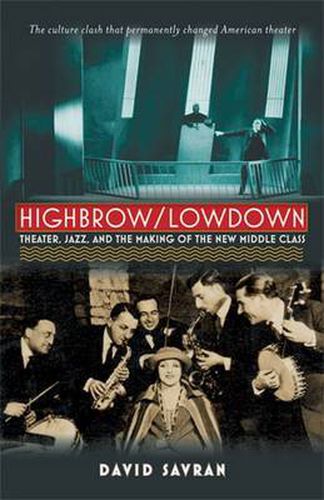Readings Newsletter
Become a Readings Member to make your shopping experience even easier.
Sign in or sign up for free!
You’re not far away from qualifying for FREE standard shipping within Australia
You’ve qualified for FREE standard shipping within Australia
The cart is loading…






Highbrow/Lowdown explores the twentieth century’s first culture war and the forces that permanently transformed American theater into the art form we know today. The arrival of jazz in the 1920s sparked a cultural revolution that was impossible to contain. The music affected every stratum of U.S. society and culture, confusing and challenging long-entrenched hierarchies based on class, race, and ethnicity. But jazz was much more than the music—it was also a powerful cultural force that brought African American, Jewish, and working-class culture into the white Protestant mainstream. When the influence of jazz spread to legitimate theater, playwrights, producers, and critics rushed to distinguish the newly emerging literary theater from its illegitimate cousins. The efforts to defeat the democratizing influences of jazz and to canonize playwrights like Eugene O'Neill triumphed, giving birth to American theater as we know it today. David Savran is Distinguished Professor of Theatre and Vera Mowry Roberts Chair in American Theatre at the Graduate Center, City University of New York.|Highbrow/Lowdown explores the twentieth century’s first culture war and the forces that permanently transformed American theater into the art form we know today. The arrival of jazz in the 1920s sparked a cultural revolution that was impossible to contain. The music affected every stratum of U.S. society and culture, confusing and challenging long-entrenched hierarchies based on class, race, and ethnicity. But jazz was much more than the music—it was also a powerful cultural force that brought African American, Jewish, and working-class culture into the white Protestant mainstream. When the influence of jazz spread to legitimate theater, playwrights, producers, and critics rushed to distinguish the newly emerging literary theater from its illegitimate cousins. The efforts to defeat the democratizing influences of jazz and to canonize playwrights like Eugene O'Neill triumphed, giving birth to American theater as we know it today. David Savran is Distinguished Professor of Theatre and Vera Mowry Roberts Chair in American Theatre at the Graduate Center, City University of New York.
$9.00 standard shipping within Australia
FREE standard shipping within Australia for orders over $100.00
Express & International shipping calculated at checkout
Highbrow/Lowdown explores the twentieth century’s first culture war and the forces that permanently transformed American theater into the art form we know today. The arrival of jazz in the 1920s sparked a cultural revolution that was impossible to contain. The music affected every stratum of U.S. society and culture, confusing and challenging long-entrenched hierarchies based on class, race, and ethnicity. But jazz was much more than the music—it was also a powerful cultural force that brought African American, Jewish, and working-class culture into the white Protestant mainstream. When the influence of jazz spread to legitimate theater, playwrights, producers, and critics rushed to distinguish the newly emerging literary theater from its illegitimate cousins. The efforts to defeat the democratizing influences of jazz and to canonize playwrights like Eugene O'Neill triumphed, giving birth to American theater as we know it today. David Savran is Distinguished Professor of Theatre and Vera Mowry Roberts Chair in American Theatre at the Graduate Center, City University of New York.|Highbrow/Lowdown explores the twentieth century’s first culture war and the forces that permanently transformed American theater into the art form we know today. The arrival of jazz in the 1920s sparked a cultural revolution that was impossible to contain. The music affected every stratum of U.S. society and culture, confusing and challenging long-entrenched hierarchies based on class, race, and ethnicity. But jazz was much more than the music—it was also a powerful cultural force that brought African American, Jewish, and working-class culture into the white Protestant mainstream. When the influence of jazz spread to legitimate theater, playwrights, producers, and critics rushed to distinguish the newly emerging literary theater from its illegitimate cousins. The efforts to defeat the democratizing influences of jazz and to canonize playwrights like Eugene O'Neill triumphed, giving birth to American theater as we know it today. David Savran is Distinguished Professor of Theatre and Vera Mowry Roberts Chair in American Theatre at the Graduate Center, City University of New York.